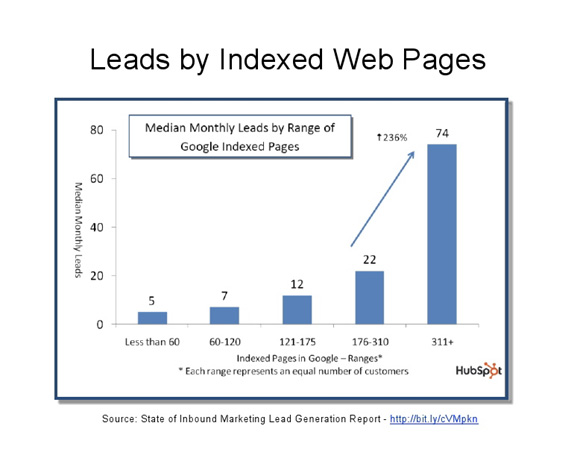 Sometimes, less is more–except when it’s not. And, when it comes to online marketing and lead generation. It seems like a no-brainer, but research from HubSpot reveals a simple truth: more content equals more traffic, and more traffic equals more leads.
Sometimes, less is more–except when it’s not. And, when it comes to online marketing and lead generation. It seems like a no-brainer, but research from HubSpot reveals a simple truth: more content equals more traffic, and more traffic equals more leads.
I don’t know any business that doesn’t want leads – which are essentially opportunities to close more business – do you?
Your website in general, and your corporate blog as an adjunct, are both marketing tools that, when used correctly, can result in leads and sales. Badda bing, badda boom. Yes, Virginia, it really is that simple.
If you share my slight obsession with numbers and statistics, consider these benchmarks as identified by HubSpot’s research:
*Company websites should have a minimum of 400 indexed pages
*Company websites should also include a minimum of 31 landing pages
*Companies should blog a minimum of 20 times/month (psst, a blog is a great way to regularly add fresh, indexable content to your website.)
If you don’t know how many pages of your website have been indexed by the search engines, you can do a quick assessment here.
The numbers are helpful, but they lead to a big question: what’s the best way to go about creating more content?
Take it from us: don’t try any tricky shortcuts in order to beef up your content pool. It might be tempting to split existing posts into smaller pieces, but you’ll end up with a sparse, unsatisfactory website that doesn’t deliver a productive user experience–and it will take its toll not just on your traffic, but on prospective leads, too.
Instead, look at ways to maximize content that you already include in your blog. Try a tactic recommended by Patrick Shea in his post about the recent HubSpot research and approach blog content from a positive and negative angle.
Let’s say there’s a new service that’s relevant for your business and industry. You’d probably write a post on the benefits of the service and how users can capitalize on the tool. But as Shea writes, don’t be afraid to approach the negative side, too. Maybe the service has some weak spots or could use some improvement. Blog about these things, too. This sort of constructive criticism will demonstrate your knowledge about the topic, and also give you a chance to subtly display how your company could help users circumvent these potential pitfalls.
And when it comes to increasing your site’s number of indexed pages, take a few minutes to establish an inventory of what you already have. We agree with Shea’s recommendations that it’s always a good idea to pursue the “low-hanging fruit” by doing simple things like creating individual bio pages, separate pages for each region/city/state/country you service and individual pages for each of your company’s services or solutions. That way, you’re not shortchanging yourself–or your company–when it comes to increasing your online content. Instead, you’re pursuing a more productive approach to outlining existing information, leaving you time to create more time-consuming pieces like white papers and demonstrations.
When it comes to creating more content for your site, how do you do it? Stay tuned for more ideas on best practices for corporate blog content – and it won’t even cost you $9.99 a month (industry joke – ignore me).
